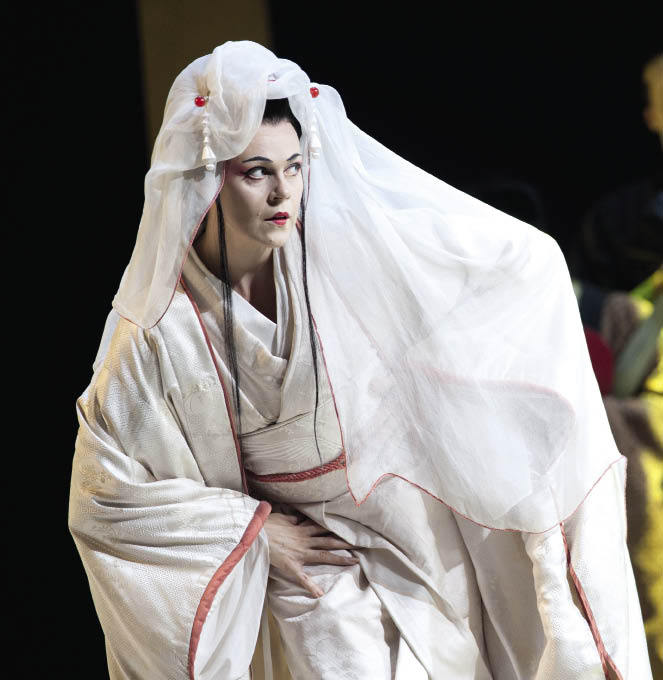Massenet’s late opera Cendrillon brings the Royal Opera’s low-key season to an effervescent if somewhat vapid close.
Massenet’s late opera Cendrillon brings the Royal Opera’s low-key season to an effervescent if somewhat vapid close. I doubt whether a better case could be made for it than in this production, imported from Santa Fe.
Laurent Pelly, an expert in contriving ingenious and non-stop action, keeps the first two acts, building up to Cinderella’s enforced departure from the ball, bowling along against an appealing background, designed by Barbara de Limburg, of wall-sized pages of Perrault’s tale, which slide away in favour of, usually, scarlet settings. There isn’t a lot of characterisation in the music, so it is achieved here mainly by blatant and often amusing sartorial means, with the two sisters parading in a series of stunning outfits that might have figured in a Fellini satire.
All the more impressive is Cendrillon’s dowdy dress and cardigan, which seem to express not only her downtrodden state, but also her tastefulness by contrast with her sisters, as well as a slight element of self-righteousness, as in Rossini’s much more comprehensive depiction of the same character. Everything about the central figure is illuminated by the stunning presence of Joyce DiDonato, who seems to have no limits to her capacity for expression through gesture and movement, while her fabulous vocal powers were only tested in a couple of high quiet notes. The most remarkable quality of this artist of genius may be the naturalness with which she does everything. I’m not sure that I have ever seen and heard a star before whose star quality is so paradoxically restrained.
Like all the greatest performers, DiDonato brings out the best in her colleagues, most emphatically in Alice Coote, who is her Prince Charmant. It’s some time since I’ve seen Coote in a role that didn’t disappoint me, given the promise that she showed ten years ago. But here she had everything: she looked and moved just as a young, bored prince should — I look forward to her Orlofsky — and sang gorgeously: two wonderful mezzo voices blending as she and DiDonato do is something so rare that one could savour even the longueurs of Acts III and IV. Instead of meeting in a forest, in Act III scene 2 they have their climactic duet among the chimneys of a town, a poignant and exquisite idea — especially since until the end they don’t actually meet; they hear but can’t find one another.
Massenet takes this tale into regions which nothing earlier in the opera has prepared us for. Finally, the Fairy Godmother, an ethereal role taken by Eglise Gutiérrez with suitable aplomb, engineers their reunion. Ewa Podles, as the fearful stepmother, is as unethereal as can be, comedy at its broadest, both to see and hear.
The contrast of tempo between the rollicking first two and often doleful last two acts is a defect, I think. Massenet’s addiction to long dying falls takes over, even though no one we care about is falling or dying. Bertrand de Billy is an efficient conductor, but he could have imparted urgency as well as plangency into the second half. There is enough that’s winning and fresh here, though, to beguile any jaded operatic palate.
More striking, in many ways, was the Royal Opera’s latest revival of Caurier and Leiser’s near-minimalist production of Madama Butterfly. I saw the last of the four performances in which Kristine Opolais took the title role, with Andris Nelsons conducting. Both were revelatory. Nelsons brought vigour to the score, where other conductors often allow it to languish; but also sought out the details of Puccini’s wonderful orchestration, and even the long orchestral passage between Acts II and III, the weakest part of the work, sustained interest. Opolais was the most complete Butterfly I have seen, very girlish in Act 1, growing into a mature and formidable as well as fragile woman in the final scenes. She was never arch, and managed the immense climaxes without stepping out of character, something few singers manage.
She had an ideal Pinkerton in James Valenti, tall, handsome and vacuous. He has a generous voice, too, and plumbed the depths of his shallow Act III aria. In an excellent supporting cast Helene Schneiderman was an outstanding Suzuki, fierce in her mistress’s defence. I haven’t before felt so forcefully the strangeness of this really brutal and violent drama — the music gets ever more beautiful and luscious as the catastrophe approaches, and though there is the fortissimo of the timpani as Butterfly prepares to meet her destiny, and the devastating orchestral conclusion, I found myself getting uneasy at the gulf that opens between the bleakness of the drama and the warmth of its orchestral and melodic cocoon. Perhaps that is what people mean by calling Puccini a sadist, or anyway what they should mean if they had a clear idea what they were talking about.
Revelatory: Kristine Opolais as Butterfly at the Royal Opera House






Comments